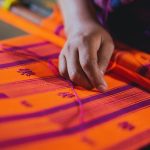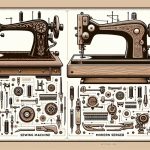Are you unsure about which needle size to use when working with denim fabric? Look no further!
This article will guide you through the importance of needle size for denim, help you understand different needle types, and provide tips on choosing the right needle for your denim sewing projects.
Say goodbye to needle breakage and confidently tackle your next denim project with the right needle size.
Let’s dive in!
Table of Contents
The Importance of Needle Size for Denim Fabric
The needle size is crucial for denim fabric because it affects the overall look and durability. When working with heavy fabrics like denim, it is important to select the right needle size to ensure the best stitch quality. The needle selection for heavy fabrics should be determined based on the thickness and weight of the fabric. Using a needle that is too small may result in skipped stitches or broken threads, while using a needle that is too large can cause visible holes or damage to the fabric.
The impact of needle size on stitch quality is significant. A needle that is too small for denim fabric may struggle to penetrate the fabric layers, leading to inconsistent stitch formation. On the other hand, using a needle that is too large can create oversized holes in the fabric, compromising its strength and durability. It is important to find the right balance between needle size and fabric weight to achieve optimal stitch quality.
Understanding Different Needle Types for Denim
You’ll want to know the specific needle type for denim fabric. When it comes to heavy-duty fabrics like denim, needle selection is crucial for optimal sewing performance. Denim is a thick and sturdy material that requires a needle capable of penetrating multiple layers without breaking or causing damage to the fabric. The recommended needle type for denim is a denim needle or a jeans needle. These needles have a sharp point and a strong shaft that can easily pierce through the dense fabric. They are specifically designed to handle the demands of sewing heavy fabrics like denim.
In order to maintain the optimal sewing performance of your denim needle, it is important to take proper care of it. After each use, make sure to remove any lint or thread that may have accumulated on the needle. This can be done by gently brushing the needle with a soft cloth or using a needle cleaner. Additionally, it is recommended to replace your needle every 8-10 hours of sewing time, as a dull or damaged needle can cause skipped stitches or fabric puckering.
How to Choose the Right Needle Size for Denim Sewing
When sewing denim, it’s important to consider the appropriate needle size for your project. Using the right needle can make a big difference in the success of your sewing.
Here are some tips to help you choose the right needle size for denim sewing:
-
Consider the weight of your denim fabric: Denim comes in different weights, so it’s important to choose a needle size that can handle the thickness of your fabric. For lightweight denim, a size 70/10 needle may work well. For medium-weight denim, a size 90/14 needle is a good choice. And for heavyweight denim, you may need a size 100/16 needle.
-
Use a sharp needle: Denim is a sturdy fabric, so using a sharp needle will help you sew through multiple layers without breaking the thread or damaging the fabric. A sharp needle will also give you clean and precise stitches.
-
Match the needle size with your denim thread: When choosing the right needle size, consider the thickness of your denim thread as well. If you’re using a thick thread, you may need a larger needle size to accommodate it.
-
Troubleshoot common denim sewing issues: If you’re experiencing skipped stitches or thread breakage while sewing denim, it could be a sign that your needle size is too small. Try using a larger needle to see if it solves the problem.
Tips for Avoiding Needle Breakage When Sewing Denim
To avoid needle breakage while sewing denim, it’s important to choose the appropriate needle size for your project. Denim is a thick and durable fabric, so using a needle that is too small can lead to needle damage and frustration. Here are some tips for preventing needle damage when sewing denim.
First, make sure you are using a needle specifically designed for denim. These needles have a sharp point and a strong shaft to penetrate the fabric without breaking. They come in various sizes, so choose the one that suits the weight and thickness of your denim.
Next, check your needle regularly for any signs of wear or damage. Needles can become dull or bent after prolonged use, which can cause them to break when sewing through thick fabric like denim. Replace your needle if you notice any issues.
When sewing denim, it’s important to use the right thread as well. A strong, heavyweight thread will help prevent needle damage and ensure the longevity of your stitches.
Lastly, take it slow and steady when sewing through thick layers of denim. Trying to rush or force the fabric can put unnecessary strain on your needle and increase the risk of breakage.
Common Needle Sizes Used for Denim and When to Use Them
If sewing a lightweight denim, it’s advisable to use a smaller needle size. Here are some needle size recommendations for different weight denim:
-
Lightweight denim (6-8 oz): Use a size 9 or 10 needle. These smaller sizes will help prevent the needle from leaving visible holes in the fabric.
-
Medium weight denim (8-12 oz): Stick with a size 12 or 14 needle. These sizes are suitable for most denim sewing projects and will provide enough strength to sew through the thicker fabric.
-
Heavyweight denim (12 oz and above): Opt for a size 16 or 18 needle. These larger sizes can handle the thick layers of heavyweight denim without breaking.
-
Stretch denim: When working with stretch denim, it’s important to use a needle specifically designed for stretch fabrics. Look for needles labeled as ‘stretch’ or ‘jersey’ needles, as they have a slightly rounded point that helps prevent skipped stitches.
Common needle problems when sewing denim include needle breakage, skipped stitches, and visible holes in the fabric. By using the appropriate needle size for your denim weight, you can minimize these issues and achieve professional-looking results.
Conclusion
In conclusion, choosing the right needle size is crucial when sewing denim fabric. By understanding the different needle types and their respective sizes, you can ensure smooth and efficient stitching.
Avoiding needle breakage is also important, and following some simple tips can help prevent this issue. Common needle sizes used for denim range from 80/12 to 100/16, depending on the thickness of the fabric.
Remember to select the appropriate needle size for your denim sewing projects to achieve professional-looking results.
- Tetron Fabric for Marine Applications: Durability and Use Cases - June 18, 2025
- Tetron Fabric for Outdoor Furniture: Weather Resistance and Care - June 18, 2025
- Tetron Fabric for Wall Coverings: Style and Application Tips - June 18, 2025





